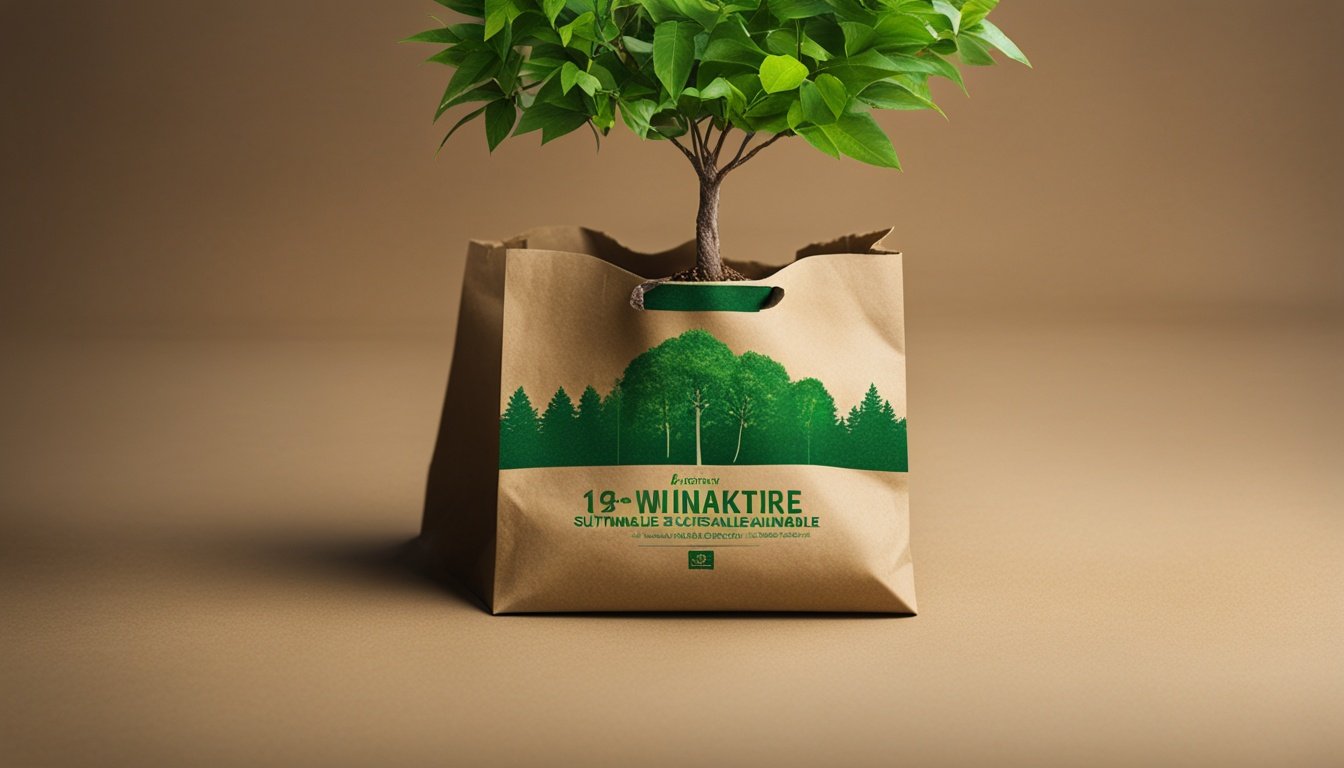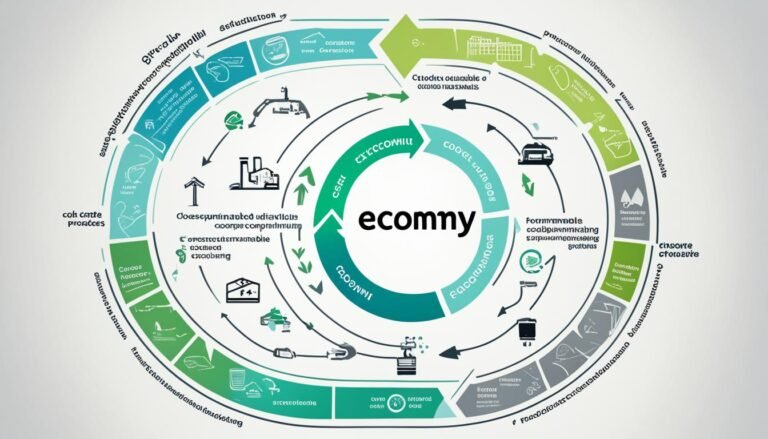Sustainable Marketing: Reaching Consumers with Eco-Conscious Messaging
Today’s market gives brands a chance to connect with environmentally savvy consumers. It’s key for companies to craft sustainable brand messaging. This is now critical for earning trust and staying ahead.
Product categories that highlight sustainability have shown double growth. Yet, while 65% want to buy from green brands, just 26% do. It’s a big challenge for businesses to win over these customers.
Generation Z, the youngest consumers, values honesty and accountability. They won’t fall for greenwashing, false eco-claims. Building eco-friendly marketing strategy and messages can boost a brand’s appeal by 33%. This makes brands more likable and trustworthy to their audience.
Brands focusing on sustainability draw in more committed customers. They may see more loyalty and support. A big group, 73% worldwide, are ready to adjust their buying for the planet. This shows the market for green products is significant and growing.
Key Takeaways
- Product categories with sustainability claims displayed double the growth compared to traditional products.
- 65% of consumers express a desire to purchase purpose-driven brands promoting sustainability.
- Sustainability messages can increase brand reach by up to 33 percentage points.
- 73% of consumers globally are willing to change consumption habits to reduce environmental impact.
- Brands that communicate sustainability effectively enhance brand relevance, engagement, and loyalty.
The Rise of Eco-Conscious Consumers
More and more people are choosing to shop with the environment in mind. They are becoming aware of how their actions affect the planet. This change is thanks to news about the environment and personal experiences that push people to buy more sustainably.
People now expect the brands they love to really care about the planet. And if they don’t, customers are willing to switch to ones that do. This shows a big shift in how people view and make their buying choices.
Consumer Behavior Shifts
In recent times, we’ve seen a real increase in buying things that are good for the planet. A survey in 2020 found over 60% of Americans would pay extra for eco-friendly packaging. At the same time, the world has been searching online a lot more for products that are kind to the earth.
What’s more, 90% of Gen Z – young people born between 1997 and 2012 – have bought products that help the environment in the last half year. This tells us younger buyers are leading the push for more sustainable options. They care a lot about the future of the planet.
Factors Driving Eco-Conscious Choices
Last year, a big study showed 93% of people worldwide thought more deeply about being eco-friendly because of the pandemic. This links health and nature closer together in people’s minds. It’s a sign of the times, illustrating that caring for the planet is just as much about our well-being as it is about the earth.
Companies are also a big part of this shift. They’re starting to take their impact on the planet more seriously. Around 60% of them think a lot about their ecological and social effects. And if stores and brands don’t prove they’re being good to the planet, 70% of shoppers are ready to find others that do.
Learning about how our choices affect the world is easier than ever thanks to the internet. And the signs of climate change surround us, in our daily lives. For example, a large part of the food we grow goes to waste. This makes consumers who care about the earth want to shop more responsibly to cut down on these inefficiencies.
All in all, the trend of shopping in ways that protect our planet seems to be growing stronger. Businesses that join in these efforts not only help the environment but also win over customers. This is an important move in making our world a better place for everyone.
Green Marketing Strategies
Businesses should embrace green marketing to meet the needs of eco-conscious customers fully. They should use green practices from making products to shipping. Social media can help spread the word about their eco-efforts.
Adapting to Consumer Demands
Green marketing began in the 1970s as people became aware of environmental issues. Over the years, it’s changed a lot. Today, customers look for real efforts, including recognized certifications.
In the 2010s, there was a big interest in green products. Now, shoppers are ready to pay more for products that are good for the earth. Companies have learned to show their eco-friendliness in their marketing. This not only makes them stand out but also saves them money by reducing waste.
Leveraging Social Influence and Good Habits
Using social platforms can boost a brand’s green image. People share and like posts about helping the planet. Activities like using renewable energy get noticed more than simple recycling efforts.
Seeing good practices online can inspire others to do the same. Brands should focus on real eco-friendly steps and not just on appearances. Tracking online reactions also helps companies improve their eco-marketing messages.
“Green marketing is no longer a niche effort; it is becoming integral to mainstream business strategies,” affirms the latest data, highlighting the importance of sustainability in today’s market.
Green marketing lets companies develop products in new, more sustainable ways. It may cost more initially, but it pays off in the long run. People follow what they see online, making real green efforts essential for the market.
Environmental Branding: Building a Greener Image
To create a strong green brand image means you must carefully plan. This plan should cover everything, from your product to how it’s priced and promoted. For today’s green-minded customers, it’s not just about looking eco-friendly. What they value most is real sustainability in everything you do.
Now, 82% of consumers see sustainability as a key issue, after the pandemic. This makes environmental branding more important than ever. Businesses, like AllMatters, show us that clear environmental branding works. It makes your brand’s reputation stronger through eco-friendly products, fair prices, easy to find goods, and messages that inform and show off environmental benefits.
Improving Brand Reputation
By focusing on sustainable branding, Google saw a 30% rise in searches for eco-friendly things in 2021. This means more people want sustainable products, improving a brand’s reputation and how well it’s known. This boost makes customers more loyal. For example, 73% of millennials would pay extra for green items. And 81% of Gen Z folks expect brands to care about environmental and social problems.
Businesses that focus on green image also get better PR and public opinion. They might even get help from the government, like tax breaks, for being green. These things help a lot in the competitive market.
Working with expert agencies can make your environmental branding even better. They can help you use sustainable materials and find digital solutions to cut your environmental footprint. This way, your brand becomes more connected to green values.
Effective Eco-Friendly Advertising Techniques
Consumers are more eco-conscious today. So, businesses are focusing on eco-friendly ads. They must attract those who care about the planet. At the same time, they need to reduce their own environmental impact.
The Role of Digital Platforms
Digital ads can be good for the earth. They target specific groups, which reduces waste and follows green marketing rules. Using a tool like Good Loop’s Carbon Calculator tracks how green your ad campaign is. This ensures it’s planet-friendly. Also, online events are better for the environment than in-person ones.
Creative Campaign Examples
Good green campaigns build trust with customers. Stories about eco actions can really draw in people who care about the planet. For instance, ads with dissolvable makeup wipes show a brand’s green efforts. Brands like Patagonia and Seventh Generation tell real stories. They connect on social media and online to reach people.
Working with eco-friendly influencers spreads your green message. They can show how your brand helps the planet. Green giveaways are fun and encourage green choices.
Print ads are vital for some eco-friendly brands. But they can choose recycled paper and eco inks. Working with green printing companies helps keep everything eco-friendly.
Well-thought-out digital and print marketing can help your brand and the planet. It makes customers want to come back. And it helps companies meet their goals in a way that’s good for everyone.
Conscious Consumerism: Aligning with Consumer Values
Conscious consumerism is not just a trend. It’s a big change in how people buy things. Today, 79% of consumers choose products that help the environment or promote fairness. This big shift makes companies focus on being sustainable and caring for the planet to keep up.
The group of conscious consumers is wide and varied. They all want honesty, eco-friendly products, and fair practices. With more focus on the environment, people see how their shopping affects the earth. They now understand their choices can make a real difference.
Changing into a conscious shopper starts with small steps. After a while, these steps turn into a new way of life. People think about their health, their kids’ health, the environment, how they feel, and what is happening in the world around them. This makes them change the way they shop.
For companies wanting to succeed in this new market, being real is key. They must show they care about what shoppers care about. Using a good story to show this, and being open and honest is very important. Creating experiences that match what people believe in builds strong loyalty and keeps them interested.
Customers who care about their health might choose products that are good for the earth. But those looking at the bigger picture might pick things that focus on wellness. This shows how eco-minded and wellness companies can help each other grow. It also shows the power of being sustainable and caring for our planet today.
Companies that understand conscious buyers do more than just sell. They help the planet and society too. Social media, like Instagram, Facebook, and Twitter, can help these companies really talk to their customers. This helps create a future where shopping is both smart and kind to the earth.
Ethical Promotion: Communicating Your Values
Good marketing about sustainability is clear and true. It’s more than just using the color green on products. It needs open talk about how a brand is working to be sustainable, what it’s achieved, and what it still does. This honesty builds trust.
It also helps consumers feel a personal connection. They see the brand’s goals as their own, leading to a strong bond.
Transparency and Authenticity
Sharing the journey to be more sustainable is key. Companies that make sustainability a big part of what they do have seen great results. They do better financially and win over more customers. For example, Stella McCartney is known for being open about its green actions.
It’s very important for a brand to be real about its values to connect with green-minded buyers. Studies show over 88% stay with brands that care about the planet or people. Brands like Innocent Drinks and Bhu:Sattva in India are respected for this reason.
Buying green products makes most people feel happier. So, connecting your marketing with ethical values is good for business and for buyers’ feelings. As many as 64% say they’re happier when they buy green.
More and more companies, 59% as of 2023, are using green materials. This means truly connecting with customers through genuine messages is key.
Choosing to be real about your brand’s values is smart. It works for both the planet and your bottom line. Through being open about its climate goals, IKEA is an example of a company finding success this way.
Sustainable Packaging Solutions
The need for packaging that’s good for the Earth is growing fast. Many shoppers now pick brands that care about the planet. This is a chance for companies to use sustainable packaging to connect with customers.
Recyclable and Reusable Packaging
Recyclable materials are key in the push for green practices. A study found 72% of people are ready to pay extra for items wrapped in recyclable materials. By using these materials, companies can meet global green goals. This can make people trust and love the brand more.
Going for recycled or biodegradable stuff not only cuts waste. It also shows the world a brand really cares about our planet. Brands that act green are seen 10% more positively. This makes their name stronger in the market.
Innovations in Packaging Design
Innovative packaging is a must for companies that want to be noticed. They can use new solutions like compostable wraps and simple designs. This helps reduce up to 60% of materials that aren’t friendly to the Earth.
Making it clear that packaging is recyclable can change how shoppers see a brand. It shows the company is serious about going green. When companies use innovative packaging design, they can also cut their carbon footprint by 20%. This is good for the planet too.
By using these tips and making sustainable packaging, brands meet the rising need for green products. They also help the planet, which makes them leaders in caring for the environment.
Cruelty-Free Products: Catering to Ethical Buyers
More and more people are looking for cruelty-free products. This shows a big move towards ethical shopping in makeup and skincare. By 2025, the market for these kinds of products could be worth over $200 billion. This presents a chance for companies that make and sell products that don’t harm animals.
Today, customers care more about the planet. This has led to a bigger market for beauty and skincare that’s kind to the earth. Almost 90% of shoppers think about how eco-friendly something is before buying it. And more than 70% are choosing greener options than they did five years back.
The growth in cruelty-free products isn’t just about not testing on animals. It’s a whole idea of meeting the needs of ethical buyers. Brands that use natural and organic stuff stand out to these shoppers. With 66% of people worldwide ready to pay extra for sustainable items, it shows doing good can be profitable.
Getting into the cruelty-free game can also lift a brand’s image up. By backing eco-friendliness and products that don’t harm animals, a company can win over socially conscious consumers. In the U.S. and Canada, almost 70% of shoppers say a brand’s sustainability is key for them.
Going cruelty-free is more than a trend; it shifts the beauty industry towards being kinder and greener. It helps the planet and builds stronger relationships with customers who care about ethical choices. It’s all about keeping up with what today’s buyers care about.
Sustainable Marketing Plans to Long-Term Success
Choosing to market sustainably is not just a fad. It’s a key step towards lasting success. Companies that make eco-friendly and ethical choices are doing better than ever. They are more efficient, manage risks well, and save money, all leading to more profits.
According to KPMG, many CEOs are ready to give up parts of their business to protect their image. This shows how important it is to be honest and environmentally conscious. When companies set green goals that align with their marketing, they gain customer trust and loyalty. This happens because they are seen as transparent and ethical.
Take IKEA, for example. They have gained more customer loyalty by being green. Their sales have gone up thanks to their focus on sustainability. Unilever, with its sustainable brands, also grows faster than others. These successes show how sustainability can lead to real business growth.
Companies not only boost their reputation through sustainability. They also come up with new ideas and find new markets. For example, using digital marketing means less paper waste. This lets businesses stand out and avoids misleading claims about being green.
Encouraging people to buy more sustainably can change the world. Companies focusing on green marketing support ethical production through their actions. This way, they make a difference in their communities and connect with customers who care about the environment. It’s a strategy that helps businesses achieve long-lasting success.
Conclusion
The move to be more earth-friendly in business is changing how we market. A lot of people, including three-fourths of millennials, think about the planet when they buy. This means companies working on being green have a better chance to succeed. Going green is no longer just a choice. It is a key part of staying important to customers and earning their trust over time.
People today care a lot about the environment, with almost everyone thinking companies should do good in the world. This belief shows up in how they shop. About nine in ten check if a product is green before they buy it. Plus, many more are choosing eco-friendly items now than they were five years ago.
So, marketing that focuses on being green helps the brand be more known and respected. This leads to customers sticking with the brand and it being more competitive. Brands that make being green part of everything they do can save money, meet rules, and get more of the market. Companies like Patagonia and IKEA show us how being honest and using new ideas in going green work well.
Source Links
- The Elusive Green Consumer
- # The Impact of Sustainability Messaging on Marketing Reach
- Shaping Success Sustainably with Green Marketing Strategies
- The Rise of the Eco-Conscious Consumer | ONiO
- The Rise of Environmentally Conscious Consumers: CX Reimagined for Sustainability – Execs In The Know
- The rise of the eco-friendly consumer
- Green Marketing 101: Strategies for a Sustainable Future | Mailchimp
- What Is Green Marketing? Strategies And Examples For Success In 2024
- Doing More Good for a Positive Impact
- Sustainable Branding: Building Green Business Identity
- Green Marketing: Engaging Consumers through Sustainability
- A Look at Sustainable Marketing in 2024
- Oddball Creative – Sustainable Advertising: Eco-friendly Practices for Your Marketing Campaigns
- Sustainable Advertising: Complete Ethical Marketer’s Guide
- The Rise of Conscious Consumerism: Key Insights for Eco and Wellness Brands
- Spot Greenwashing as an Eco-conscious Consumer » Sustainability » University of Florida Business Affairs » University of Florida
- Marketing for the Mindful Generation: Strategies for Reaching Conscious Consumers
- Sustainable Marketing Strategies: 5 Eco-Friendly Brands Leading the Way
- Sustainable Marketing Strategies: Building a Future-Focused Brand
- Why Gen Z Values Sustainability: Tips for Marketing to the Eco-Conscious Generation. | Kadence
- Sustainable Marketing: 5 Ways to Express Eco-Friendly Business Practices in Marketing
- What marketing strategies are in place to promote your move toward recyclable packaging by 2024? – BayWater Packaging
- 10 ways that sustainable packaging impacts brand success
- Guidelines for Launching an Online Eco-Friendly Cosmetics Brand
- Green Marketing: Integrating Sustainability into Marketing Strategies
- Sustainable Beauty: A Movement Redefining the Cosmetics Industry
- Sustainable Marketing: Why it represents the future of business.
- How to Market Sustainable Products
- What is sustainable marketing and how should you use it? | Smart Insights
- Sustainability and Green Marketing in 2023: Appealing to Eco-Conscious Consumers
- Going Green: How Eco-Conscious Marketing Can Benefit Your Brand and the Environment
- The Growing Importance of Sustainability in Marketing








